Publications
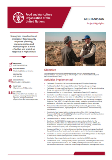
Afghanistan: Project Highlights – OSRO/AFG/206/USA
09/2023
The Government of the United States of America contributed USD 500 000 to strengthen coordination of emergency food security response in Afghanistan by supporting the work of the Food Security and Agriculture Cluster.

Somalia: Project Highlights - OSRO/SOM/204/USA
09/2023
The Government of the United States of America contributed USD 600 000 to the FAO project, "Improving flood and drought risk management in Somalia – SWALIM", which as implemented from 1 January 2022 to 30 June 2023.

Anticipating El Niño: A mitigation, preparedness and response plan
09/2023
FAO’s El Niño Mitigation, Preparedness and Response Plan is an urgent appeal to be implemented in close collaboration with government partners and other humanitarian actors in Somalia.
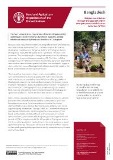
Bangladesh: Belgium's contribution through the Special Fund for Emergency and Rehabilitation Activities (SFERA)
09/2023
Through the Special Fund for Emergency and Rehabilitation Activities, the Government of Belgium contributed USD 500 000 to the Food and Agriculture Organization of the United Nations (FAO) to mitigate the adverse impacts of severe floods and landslides that affected Chattogram division of Bangladesh during August 2023.

The Niger: DIEM – Data in Emergencies Monitoring brief, round 7
09/2023
This Data in Emergencies Monitoring (DIEM-Monitoring) brief shares the results of a seventh-round assessment conducted in July 2023 in the Niger.
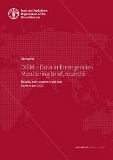
Somalia: DIEM – Data in Emergencies Monitoring brief, round 6
09/2023
This Data in Emergencies Monitoring (DIEM-Monitoring) brief shares the results of a sixth-round assessment conducted in June and July 2023 in Somalia.
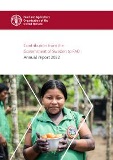
Contribution from the Government of Sweden to FAO: Annual report 2022
09/2023
In 2022, the Government of Sweden, through the Swedish International Development Cooperation Agency, contributed nearly SEK 141 million (USD 14.5 million) to the Food and Agriculture Organization of the United Nations (FAO).
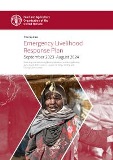
The Sudan Emergency Livelihood Response Plan, September 2023–August 2024
09/2023
Restoring and enhancing food production and strengthening agricultural livelihoods to support farming, herding and fishing communities

Haiti: DIEM – Data in Emergencies Monitoring brief, round 4
09/2023
This Data in Emergencies Monitoring (DIEM-Monitoring) brief shares the results of a fourth-round assessment conducted from May to July 2023 in Haiti.

Northeastern Nigeria: Adamawa, Borno and Yobe states – Response overview (September 2023)
09/2023
The latest Cadre Harmonisé analysis (March 2023) conducted in 26 out of Nigeria’s 36 states, as well as the Federal Capital Territory, estimates that 24.8 million people countrywide were projected to be acutely food insecure during this year’s lean season
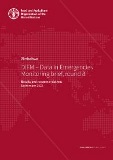
Zimbabwe: DIEM – Data in Emergencies Monitoring brief, round 8
09/2023
This Data in Emergencies Monitoring (DIEM-Monitoring) brief shares the results of a eighth-round assessment conducted in July 2023 in Zimbabwe.

Building durable solutions for refugees and host communities through inclusive value chain development in Uganda
09/2023
Uganda hosts over 1.5 million refugees, primarily displaced due to violence and civil unrest in neighbouring South Sudan and the Democratic Republic of the Congo.
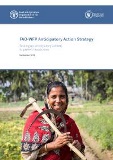
FAO-WFP Anticipatory Action Strategy: Scaling up anticipatory actions to prevent food crises – September 2023
09/2023
Recognizing that the increasing number of food crises require resources and capacities far beyond the reach of any individual organization, the Food and Agriculture Organization of the United Nations (FAO) and the World Food Programme (WFP) are partnering together to scale up the reach of Anticipatory Action.

Sustaining peace in the Sahel and West Africa: Lessons learned and best practices from FAO Peacebuilding Fund projects
09/2023
Since 2018, the portfolio of PBF projects implemented by FAO in the region has consolidated considerably, with a tripling of funding mobilized.

Subregional West Africa: Project Highlights - OSRO/SFW/200/USA
09/2023
The Government of the United States of America through the Bureau for Humanitarian Assistance of the United States Agency for International Development contributed USD 300 000 to the Food and Agriculture Organization of the United Nations (FAO) for the implementation of a project entitled “Regional project to enhance preparedness and response to increased acute food insecurity of vulnerable households through improved coordination in the Sahel and West Africa".

Vanuatu: Response overview, August 2023
09/2023
On 1–3 March 2023, Tropical Cyclone Judy and Tropical Cyclone Kevin caused significant damage and losses to the agriculture sector and its subsectors in Vanuatu, exceeding USD 120 million.

The Democratic Republic of the Congo: DIEM – Data in Emergencies Monitoring brief, round 6
09/2023
This Data in Emergencies Monitoring (DIEM-Monitoring) brief shares the results of a sixth-round assessment conducted in May and June 2023 in the Democratic Republic of the Congo.
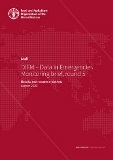
Mali: DIEM – Data in Emergencies Monitoring brief, round 5
09/2023
This Data in Emergencies Monitoring (DIEM-Monitoring) brief shares the results of a fifth-round assessment conducted in May and June 2023 in Mali.

The Plurinational State of Bolivia: Belgium's contribution through the Special Fund for Emergency and Rehabilitation Activities (SFERA) – Anticipatory Action window
08/2023
The population of the Altiplano, mostly indigenous, has the highest poverty rate in the country, and relies on subsistence agriculture as its main livelihood (potato, quinoa, cañahua, barley, oats and alfalfa).
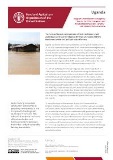
Uganda: Belgium's contribution through the Special Fund for Emergency and Rehabilitation Activities (SFERA) – Anticipatory Action window
08/2023
Uganda is a disaster-prone country affected by various types of hazards, with a 16 out of 191 countries ranking in terms of risk, driven by the increasing frequency, intensity and scale of disasters affecting the country.
